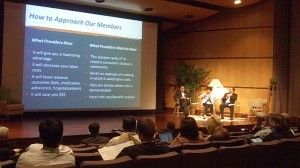Why America Needs Seniors to Remain Healthy and in Their Homes – Huffington Post
I recently saw an article in the Huffington Post by Kenneth Thorpe called “Why America Needs Seniors to Remain Healthy and in Their Homes”. While I absolutely agree with the article, I felt a critical piece of the puzzle was completely left out of the article. He didn’t mention the symbiotic use of in-home/digital home health technologies… It’s true that in order to save this country from entering a black hole of debt (with the HUGE aging boom) we need to figure out new ways to stay independent, safe, happy and healthy at home! We need to utilize not only home health providers, but also embrace technology that can show the big picture/long term trends e.g. increased/decreased motion, restless sleeping patterns, abnormal vitals, etc. Benjamin Franklin once said an ounce of prevention is worth a pound of cure, I sure wish we took this more to heart. Hospitals are used too often because we didn’t focus at all on prevention. Hospitals should ONLY be used for cure. In-home technologies like GrandCare gathers info about the household (when/if someone gets out of bed, if front door opens during the night, meds not accessed, abnormal vitals, fridge not accessed during mealtimes, heat not working, etc…) The caregiver can then respond to the alerts. A socialization component allows online care & calendar coordination and communication with the Loved One (notes, emails, videos, pictures & SKYPE through a simple touchscreen interface). Tech WITH hands-on Care will be the ultimate solution. There is no reason that a person needs to stay awake 24 hours a day caring for a Loved One, when a system can gently wake them and notify them if assistance is needed. It’s not a matter of If, but a matter of when! Discovery Channel did quite a nice piece on the future of aging, they talked about everything from Medication Dispensers to remote monitoring systems to SKYPE and GPS-enabled shoes…take a look: http://dsc.discovery.com/videos/discovery-channel-cme-future-family-part-2.html#mkcpgn=fb3
Thanks to the Huffington Post for dedicating time to this critical topic!
Take a look below
With many Republicans forecasting the end of Medicare for those under 55 and few members of my own Democratic Party willing to propose sweeping reforms to preserve it, several Washington insiders speculate that serious Medicare reform will remain a third rail of American politics.
Yet based on my experience, common ground on Medicare is possible and, in the short term, policymakers have an immediate and time-sensitive opportunity to prevent and manage costly chronic illnesses such as cancer, diabetes and hypertension through a coordinated approach to treating patients led by home health care. By strengthening options that let people get much-needed care at home, policymakers can save money, give older Americans what they want and address the chronic disease epidemic facing our nation.
Consider the following: Nearly three quarters of those who live to 85 will eventually need health assistance ranging from simple help around the house to 24-hour skilled nursing care. According to the Department of Health and Human Services, a week in a private nursing home room costs about $1,500 while a week of home health care costs considerably less.
If Congress accelerates already planned cuts in home health care (currently under consideration) or raises fees on seniors even more, it will encourage many to enter costly nursing homes and, eventually, increasing the overall cost of the Medicare program. This defies fiscal and political logic.
Moreover, policies that force seniors into nursing homes through cuts to home health spending will directly impact our efforts to prevent and manage chronic disease. The cuts reduce the capacity to provide health care services to chronically ill patients at home. Patients with chronic disease account for 75 percent of U.S. health spending and the numbers are higher in entitlement programs. Eighty-three percent of every dollar in Medicaid is spent on chronic disease and 99 percent in Medicare.
The best chance America has to alleviate this burden is by creating a coordinated team-based approach to health care in which doctors, nurses, nurse practitioners, home health aides and patients are all working together to treat and get in front of chronic conditions. While some individuals have needs that require care only institutional settings can provide, few should leave friends, family, and familiar places simply because they need extra help.
Home health aides spend much more “face time” with seniors and disabled persons than doctors and nurses. Our medical system must take advantage of this. With better information technology — interoperable electronic medical records in particular — and improved integration between health providers of all sorts, home health workers can serve as a “front door” to a better-coordinated medical system. Improved coordination of care, in turn, can save money (it’s almost always cheaper to treat problems early), reduce medical errors, and improve quality of life for Americans on Medicare.
Such home and community-based solutions should appeal to both ends of the political spectrum. Republicans intent on cutting the budget should know that they’ll save money by reducing the need for institutional care. Democrats who want to raise the quality of public services should be secure in the knowledge that home health care spending will do just that. Providing opportunities for patients to receive their health care services at home rather than at more expensive institutional settings is a common sense solution.
To see the entire article: http://www.huffingtonpost.com/kenneth-thorpe/medicare-cuts_b_885195.html

 Technology that is properly applied will not only enable, but also strengthen the social bonds between the loved one, their caregiving network and future generations. A successful technology will consider all of the aspects of aging to positively affect physical, emotional, mental and spiritual wellness. If our society does not embrace available technologies to encourage responsible aging, the healthcare costs and the emotional toll taken on familial caregivers will be staggering. Charlie Hillman Founder, GrandCare Systems
Technology that is properly applied will not only enable, but also strengthen the social bonds between the loved one, their caregiving network and future generations. A successful technology will consider all of the aspects of aging to positively affect physical, emotional, mental and spiritual wellness. If our society does not embrace available technologies to encourage responsible aging, the healthcare costs and the emotional toll taken on familial caregivers will be staggering. Charlie Hillman Founder, GrandCare Systems



 Amos Adler, President, Memotext
Amos Adler, President, Memotext



